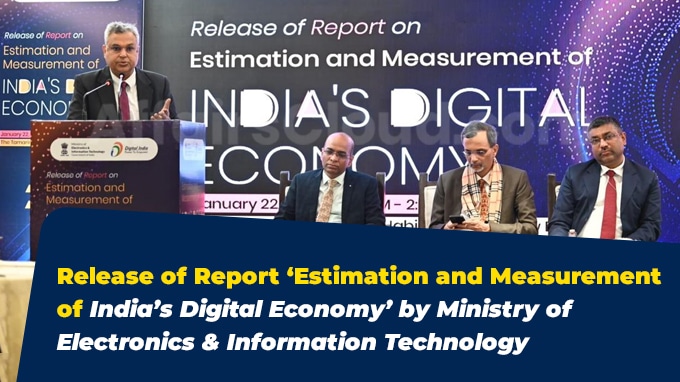 In January 2025, the Ministry of Electronics and Information Technology (MeitY) released a comprehensive report titled ‘Estimation and Measurement of India’s Digital Economy’, prepared by the Indian Council for Research on International Economic Relations (ICRIER). This marks the first attempt to quantify the digital sector’s impact on India’s income and employment.
In January 2025, the Ministry of Electronics and Information Technology (MeitY) released a comprehensive report titled ‘Estimation and Measurement of India’s Digital Economy’, prepared by the Indian Council for Research on International Economic Relations (ICRIER). This marks the first attempt to quantify the digital sector’s impact on India’s income and employment.
- According to the report, India’s digital economy is projected to grow nearly twice as fast as the overall economy, contributing to almost one-fifth of national income by 2029-30.
- In less than six years, the digital economy’s share will surpass that of agriculture or manufacturing in India.
Methodologies:
i.The report uses global methods from the Organisation for Economic Co-operation and Development (OECD) and the Asian Development Bank (ADB) to estimate the size of India’s digital economy as a share of national income and employment.
ii.It also includes the digital shares of industries such as trade, Banking, Financial Services, and Insurance (BFSI), and education.
iii.The survey was conducted in partnership with the Confederation of Indian Industry (CII) and supported by MeitY, especially for data from the banking sector. The sample was restricted to the corporate sector and comprised the top 10-30 companies in each industry, especially those in which digitalisation was most likely.
Key Findings:
Current contribution:
The report estimates that India’s digital economy accounted for 11.74% of India’s income in 2022-23, contributing Rs. 28.94 lakh crore (Approximately USD 368 billion) in Gross Value Added (GVA) and Rs. 31.64 lakh crore (Approximately USD 402 billion) in Gross Domestic Product (GDP).
- This share is projected to rise to 13.42% by 2024-25
Key Contributors:
i.The largest contribution, 7.83% of the national GVA, is driven by sectors such as Information and Communication Services, Telecommunications (ICT), and the manufacturing of electronics, computers, and communication equipment.
- While the traditional ICT sector remains the largest component of the digital economy, digital platforms and the digitalization of brick-and-mortar sectors are growing rapidly
ii.The new digital industries, including Big Tech, digital platforms, intermediaries, and firms reliant on digital intermediaries, contribute nearly 2% of the national GVA.
iii.The digital contribution of three traditional industries (BFSI, trade, and education), not included in the OECD framework but part of the estimates, makes up 2% of the national GVA.
Contribution to Employment:
i.In 2022-23, the digital economy accounted for 14.67 million workers or 2.55% of India’s workforce.
ii.Agriculture accounted for 263.6 million workers (or 45.8% of the total workforce), while manufacturing employed 65.6 million workers (or 11.4% of the workforce).
Global Rank :
According to India’s Digital Economy Report 2024 states that India is the third largest digitalised country in the world in terms of overall economy-wide digitalisation after the United States of America (USA) and China.
- It ranks 12th among (Group of 20) G20 nations in individual user digitalisation.
About Indian Council for Research on International Economic Relations (ICRIER):
ICRIER is an autonomous, policy-oriented, not-for-profit, economic policy think tank.
Chairman – Pramod Bhasin
Headquarters – New Delhi (Delhi)
Founded – 1981
About Ministry of Electronics and Information Technology (Meity):
Union Minister– Ashwini Vaishnaw (Rajya Sabha- Odisha)
Minister of State (MoS)- Jitin Prasada (Constituency- Pilibhit, Uttar Pradesh, UP)




